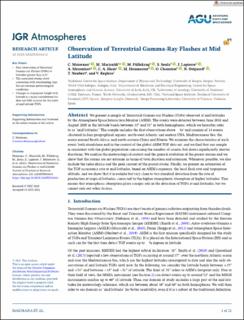| dc.contributor.author | Maiorana, Carolina | |
| dc.contributor.author | Marisaldi, M. | |
| dc.contributor.author | Füllekrug, Martin | |
| dc.contributor.author | Soula, Serge | |
| dc.contributor.author | Lapierre, J. | |
| dc.contributor.author | Mezentsev, Andrey | |
| dc.contributor.author | Skeie, Chris Alexander Kallevik | |
| dc.contributor.author | Heumesser, M. | |
| dc.contributor.author | Chanrion, Olivier | |
| dc.contributor.author | Østgaard, N. | |
| dc.contributor.author | Neubert, Torsten | |
| dc.contributor.author | Reglero, Victor | |
| dc.date.accessioned | 2022-03-16T11:39:54Z | |
| dc.date.available | 2022-03-16T11:39:54Z | |
| dc.date.created | 2021-10-13T15:36:53Z | |
| dc.date.issued | 2021 | |
| dc.identifier.issn | 2169-897X | |
| dc.identifier.uri | https://hdl.handle.net/11250/2985506 | |
| dc.description.abstract | We present a sample of Terrestrial Gamma-ray Flashes (TGFs) observed at mid latitudes by the Atmosphere Space Interaction Monitor (ASIM). The events were detected between June 2018 and August 2020 in the latitude bands between 35° and 51° in both hemispheres, which we hereafter refer to as “mid latitudes.” The sample includes the first observations above urn:x-wiley:2169897X:media:jgrd57293:jgrd57293-math-0001 and consists of 14 events clustered in four geographical regions: north-west Atlantic and eastern USA; Mediterranean Sea; the ocean around South Africa; and north-eastern China and Siberia. We examine the characteristics of each event, both standalone and in the context of the global ASIM TGF data set, and we find that our sample is consistent with the global population concerning the number of counts, but shows significantly shorter durations. We analyze the meteorological context and the general evolution of the parent storms and we show that the storms are not extreme in terms of total duration and extension. Whenever possible, we also include the radio sferics and the peak current of the parent stroke. Finally, we present an estimation of the TGF occurrence rate at mid latitudes, based on ASIM's exposure, the local flash rate and tropopause altitude, and we show that it is outside but very close to two standard deviation from the rate of production at tropical latitudes, corrected by the higher atmospheric absorption of higher latitudes. This means that atmospheric absorption plays a major role in the detection of TGFs at mid latitudes, but we cannot rule out other factors. | en_US |
| dc.language.iso | eng | en_US |
| dc.publisher | Wiley | en_US |
| dc.rights | Attribution-NonCommercial-NoDerivatives 4.0 Internasjonal | * |
| dc.rights.uri | http://creativecommons.org/licenses/by-nc-nd/4.0/deed.no | * |
| dc.title | Observation of Terrestrial Gamma-Ray Flashes at Mid Latitude | en_US |
| dc.type | Journal article | en_US |
| dc.type | Peer reviewed | en_US |
| dc.description.version | publishedVersion | en_US |
| dc.rights.holder | Copyright 2021. The Authors | en_US |
| dc.source.articlenumber | e2020JD034432 | en_US |
| cristin.ispublished | true | |
| cristin.fulltext | original | |
| cristin.qualitycode | 2 | |
| dc.identifier.doi | 10.1029/2020JD034432 | |
| dc.identifier.cristin | 1945667 | |
| dc.source.journal | Journal of Geophysical Research (JGR): Atmospheres | en_US |
| dc.identifier.citation | Journal of Geophysical Research: Atmospheres. 2021, 126 (18), e2020JD034432. | en_US |
| dc.source.volume | 126 | en_US |
| dc.source.issue | 18 | en_US |

